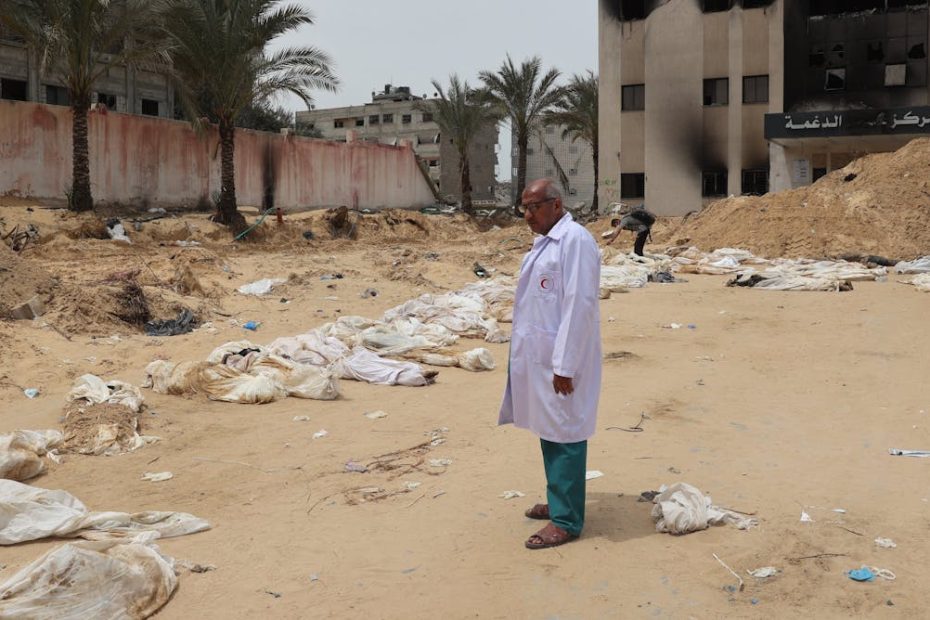From Myanmar to Gaza, Ukraine to Sudan – 2024 is another grim year according to our Mass Atrocities Index
With major conflicts in Africa, the Middle East, Europe and Southeast Asia, 1 in 8 people globally will face conflict in 2024 – another worrying year in terms of massive human suffering. In fact, 111 countries around the world experienced some form of mass atrocities during the year.
This is what colleagues and I at the University of Denver’s Pardee Institute confirmed when we analyzed the latest global data sets on recent and ongoing mass atrocities.
The project, which covers nearly 200 countries, aims to look beyond any single tragedy or conflict and objectively try to determine the extent of humanitarian suffering around the world. Each country is then assigned a score from 0-100 based on our atrocity scope and scale heuristic, providing a single indicator of the breadth and severity of atrocities committed in a given year.
In this project, we define mass atrocity as an act of violence against 25 or more defenseless members of a social, cultural, ethnic, religious, or political group, or a threat to the survival of that group.
Although we will see fewer global atrocities in 2024 than in 2023, it will still be more than in any other year since 2018. While the number of deadly atrocities decreased in 2024 compared to the previous year, there were higher numbers of several types of “less deadly” atrocities – operations involving large-scale serious, deliberate violations of human rights other than murder.
From worst to still bad
In 2023, the situation is bleak. More than one million people have been forcibly displaced in war-torn Ukraine and the Gaza Strip. Tens of thousands of civilians were killed in Southeast Asia, the Middle East and Eastern Europe. In the first months of Israel's war in Gaza, the daily death rate was higher than in any other conflict of the 21st century.
The overall scale of atrocities fell slightly in 2024 from the previous year, but much of the suffering worldwide continues. By the end of the year, approximately one in 10 Palestinians living in Gaza had been forcibly displaced at least once, and in most cases multiple times. After nearly four years of civil war, mass killings of civilians continue in Myanmar's ongoing conflict. The country's ruling junta tortured people and reportedly burned them alive, and both the military and the rival Arakan Army rebel group were allegedly involved in the ethnic cleansing of Rohingya Muslims, with ethnic tensions spreading to Indian border.
The humanitarian situation in the Democratic Republic of the Congo also remains dire. The Congolese government, fed up with the UN's inability to quell violence in Congo's North Kivu and Ituri provinces, has begun expelling UN peacekeepers and African regional peacekeepers. The northeastern region of the country is regularly subject to murders and rapes by groups such as these. Rwanda-backed M23 militia.
Sudan is another shocking example of escalating atrocities in 2024. As the civil war raged on, the Rapid Support Forces paramilitary group carried out numerous extrajudicial killings against Sudanese troops. This comes against the backdrop of widespread sexual slavery and other atrocities in Sudan's war zones, including atrocities committed by the Sudanese army itself, such as the bombing of civilian targets.
Incidents of what my team considers low-level brutality persist elsewhere and in areas of active humanitarian crisis, from South African groups attacking Zimbabwean immigrants over alleged “witchcraft” to German police beating Palestinians during last spring's international protests against the Gaza war . Only 84 countries (or less than half of those tracked by my team) escaped 2024 without any deadly or less deadly mass atrocities. This number is the same as in 2023, but significantly worse than in 2018 for the 97 countries where atrocities did not appear to have occurred.
Some countries with ongoing atrocities between 2018 and 2024 – including Ukraine, Israel and the Occupied Palestinian Territory, Congo, Sudan and Russia – have seen their numbers increase in recent years.
On the bright side, humanitarian conditions improved in some countries in 2024. In Bahrain, for example, King Hamad bin Issa Al Khalifa marked the end of Ramadan by releasing hundreds of political prisoners, although hundreds more remain arbitrarily detained. While the number of political incarcerations in Azerbaijan increased in 2024, overall levels of violent atrocities fell significantly relative to 2023 as the country's leaders sought a peace treaty with Armenia. The situation in Venezuela, Eritrea and Mexico has also improved significantly from previous years, although it is still far from ideal.
Overall, the record of atrocities in 2024 and efforts to quell them has been mixed. Mass murder appears to have declined compared to 2023, as has non-lethal violence in the form of torture, beatings and related force. But we are also seeing an increase in other unwelcome violence. Recruitment of child soldiers has increased globally, with the number of child soldiers in Haiti increasing by 70% from the previous year. In Afghanistan, the Taliban's enactment of a morality law in summer 2024 – which rights groups say targets women, the LGBTQ+ community and religious minorities – fits into a broader global trend of unequal legal treatment of minorities combine.
Group violence against women is widespread in Afghanistan and elsewhere. The United Nations estimates that by 2023, a woman will be killed every 10 minutes. Our data suggests this statistic is unlikely to improve by 2024.
Outlook for the year ahead
Where are we headed in 2025?
The chance of a final peace agreement between Azerbaijan and Armenia remains, with the potential for a significant reduction in violence. More important is ending the wars in Ukraine and Gaza – although the prospects for lasting peace here are also uncertain.
Sadly, we can expect more human suffering in Congo, Myanmar and Sudan, where conflicts have no clear end in sight.
It might be helpful to keep track of atrocities in the meantime. If nothing else, in the words of Holocaust survivor, activist and Nobel Prize winner Elie Wiesel, we can and should continue to bear witness. By doing this systematically, we increase the chances that perpetrators will one day be held accountable. We are also improving our ability to track those who are not being held accountable and opening up dialogue on how to better address such challenges in the future.









